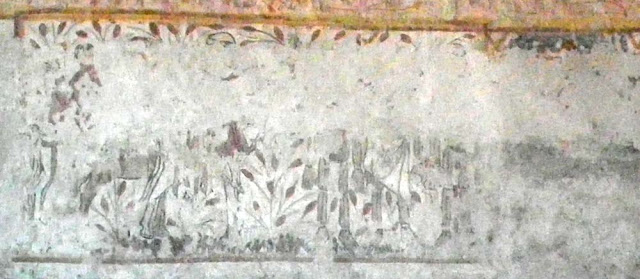On Saturday 10 September the Association de Botanique et de Mycologie de Sainte Maure de Touraine met at Berthenay for an outing on the Loire sands. Berthenay bills itself as 'the end of the world', being as it is in the triangle formed by the confluence of the Cher to the south and the Loire to the north.
The outing was on the Ile du Passeur, a large gravel and sand bank close to the southern bank of the Loire that has formed an island. It is accessible by foot in the summer when the water levels are at their lowest. What we hadn't realised about the island though, until Jeannine was asked what she was doing peering into the bushes, was that it is a popular dogging spot. Apparently this year, with the seemingly endless good weather of late summer it's been even more popular than usually for this particular outdoor activity. However, French botanists are made of stern stuff, and we continued regardless.
Paul demonstrating how to use an acorn cup as a whistle.
The island is directly opposite the 2000 year old Roman tower called the
Pile Cinq Mars (pronounced locally as though the name was Pile Saint Mar).
La Pile Cinq Mars.
Inevitably, as all the rivers here are, the island is invaded by
Water Primrose Ludwigia spp (Fr.
jussie). Dominique found a patch which had two different species growing together --
L. grandiflora (Fr.
jussie à grandes fleurs, the most abundant) and
L. peploides (Fr.
jussie peploïde).
The two Water Primrose species --
L. grandiflora with narrow pointed leaves (left) and L. peploides with spoon shaped leaves (right).
Water Primrose L. grandiflora in full lush growth, despite the drought.
Corn Mint Mentha arvensis (below) can be distinguished from Water Mint M. aquatica because it does not have a terminal head of flowers. They are otherwise very similar and you can't just assume that it must be Water Mint if it is growing near water. Annoyingly, for those of us who like our botany to be clear cut, they hybridise too.
A view across the Ile du Passeur -- lots of sand and poplar saplings.
An oxbow lake A summer river pond in the middle of the island.
Thorn-apple Datura stramonium usually has white flowers, but on the island it has pale purple flowers. This now global weed was once cultivated to extract alkaloids to treat asthma. This year being hot and dry it is abundant. It must like sand because I have noticed it a lot this year amongst the asparagus rows near Descartes.

A strange caterpillar dropped on to the hat of one of our group and was surrounded by camera lenses. None of us had ever seen anything like it. Then someone accidentally prodded it in a way it objected to. It instantly went into a pose that we recognised. No one could remember the name but we knew we'd seen it in
Chinery. For those of you unfortunate enough not to have immediate and 24 hour access to the best general insect guide for Western Europe that there is (in English and translated into French), I will relieve your suspense and name the beast. It is the caterpillar of a Poplar Kitten moth
Furcula bifida. Those of you who do own Chinery will realise that the illustration we all recalled so clearly is actually of a closely related species, but we all know that Chinery often just gets you to the right family and if you want the right species you need to look a bit further. In the case of moths,
UK Moths is my go-to resource.

On the other side of the island, the main channel of the Loire.
An indication of how high the
floods in June were. This Common Ash tree
Fraxinus excelsior has a tide mark, with dead brown silt covered leaves below and healthy green leaves above.
Further Reading: On this 2016 visit I was lucky enough to see a rare dragonfly, the Green Snaketail
Ophiogomphus cecilia, which I wrote about
here. The botany club I belong to has visited the Loire sands at Berthenay before. I wrote about it
here and
here.


























































